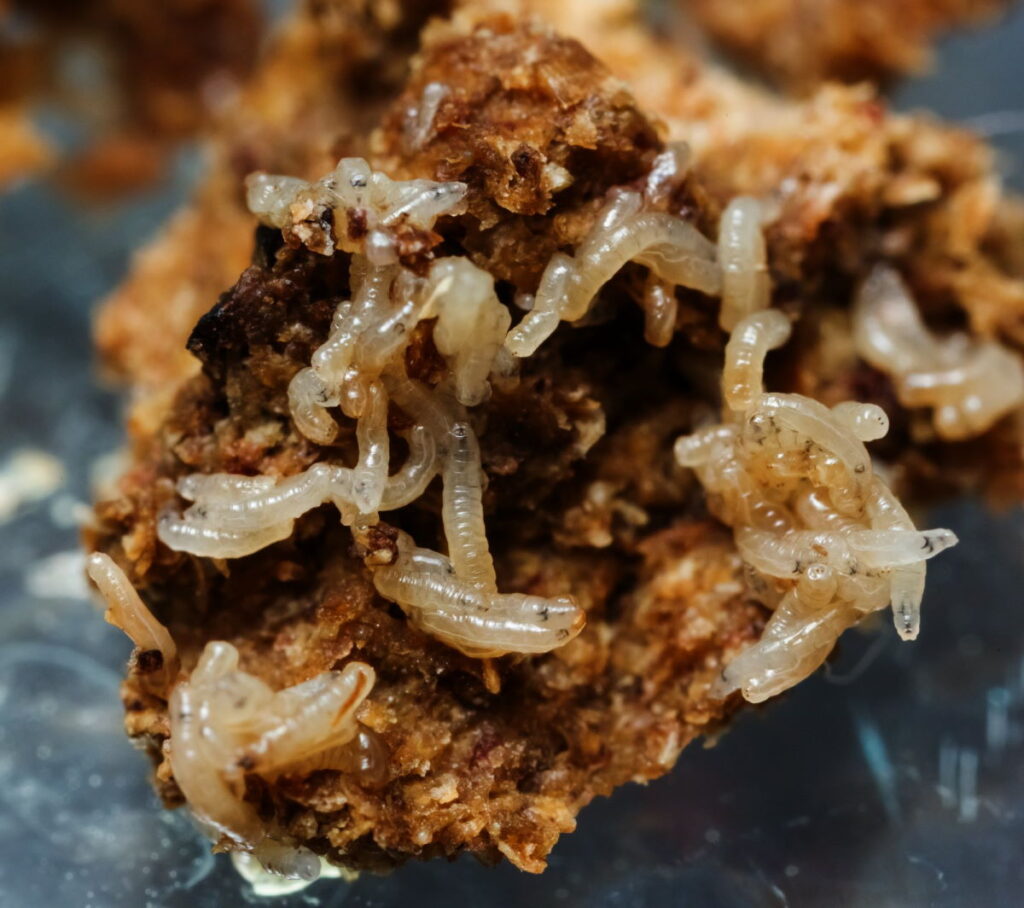You are out turning your compost and notice that part of it is moving…looking closer, you see maggots in your compost. Will they ruin your compost? Do you get rid of them? How? We’ll talk about this and more as we look at handling maggots in compost.
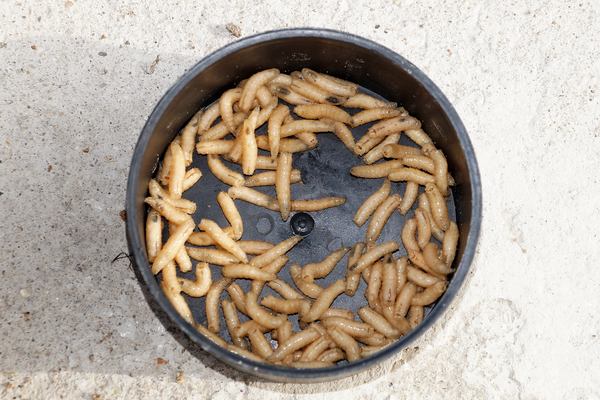
What Exactly Are Maggots?
Maggots look like little (up to ½-1 inch in length) worms. They are shaped a bit like a torpedo, and you’ll often see them wiggling around in your compost. They start off as off-white or white in color but can become gray, light brown, or dark brown as they age. The actual color varies based on what they eat. They are fly larvae (i.e., baby flies). The maggots in compost are typically the larvae of black soldier flies. These are black flies that look like larger, chubbier houseflies.
A female black soldier fly can lay 200-650 eggs, so you’re likely to see a good number of maggots in your compost when you see them.
What Attracts Them to Your Compost
A few things could be going on in your compost to attract flies (who then lay eggs which become maggots.)
First, compost has a lot of nutrients and is a good place for them to grow into big and strong flies. At some level, you can’t fix that.
They do prefer a warm, humid environment. Unfortunately, that means that compost can be a good place for them to grow up, but if your compost is too moist, it’s more likely to attract maggots. This is usually because you have too many greens and not enough browns or your aren’t turning it enough to spread things out.
Are Maggots in Compost A Problem?
The short answer is no; it’s not a problem. In fact, black soldier flies do a good job of composting for composting and can help speed up your composting.
Aesthetically, many people don’t like the look or thought of maggots in their compost. In other words, they freak some people out, so we’ll talk about ways to remove them and keep them out. Plus, they become flies, and flies are annoying. Flies lay A LOT of eggs, meaning many flies that can end up in your yard or even in your house.
You also don’t want too many of them. There is concern that they will eat all the nutrients. Having them in there for a while could speed up composting, but keeping them there will take away some of the benefits of your compost.
How to Handle Maggots in Compost
When you have maggots in your compost, you have a couple of decisions to make. You can leave them and try to prevent more in the future, you can try to get rid of the ones you have or just let things be. We’ll go over the options and why you might consider them (and how to do them.)
Just Leave Them
One thing that you can do is just leave them. You definitely don’t want your compost to become a new housing development for maggots, but having some in there for a while isn’t the end of the world. Probably the best strategy is to leave them be while you work on the other methods below so that your compost isn’t a great home for them and they don’t have access.
If your compost is infested with maggots, then you definitely want to do something. They are likely removing valuable nutrients from the compost you want for your garden or flower bed.
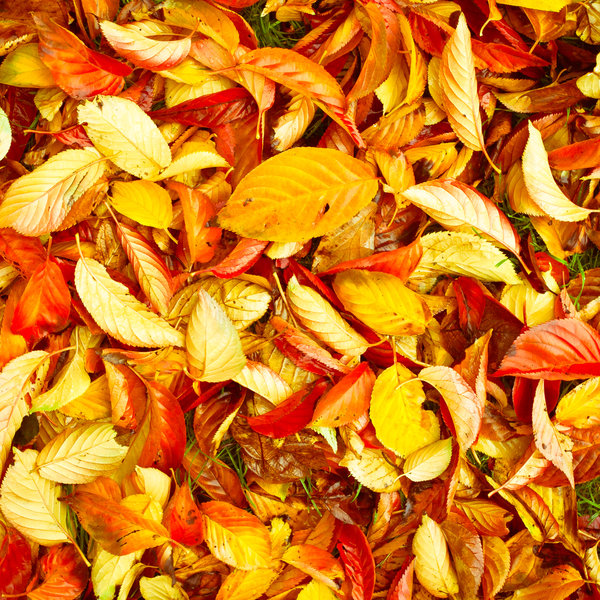
Add More Brown Material – Often the Most Effective
Adding more browns like leaves, cardboard, paper, and such will help to remove some of the moisture in your compost. These materials tend to soak up some of the moisture. Your compost should be about the consistency of a wrung-out sponge.
If it’s dripping water when you pick it up, or it feels very wet, then it’s too moist, and you need to fix that. The easiest way is to add some browns to soak up some of the moisture.
Pine needles can be a good option. They do take a while to break down, but they are brown and have the added benefit of being a repellant for the black soldier flies.
Maggots also love nitrogen-rich food (greens), so adding browns dilutes those and makes your compost less inviting for flies.
You could cut down on the greens that you add, but it’s usually easy to find leaves, paper, or an old Amazon box to cut up and toss in your compost.
This then dries up the compost, and the flies are less likely to be attracted to it. Hopefully, they’ll move on and find somewhere else to lay their eggs.
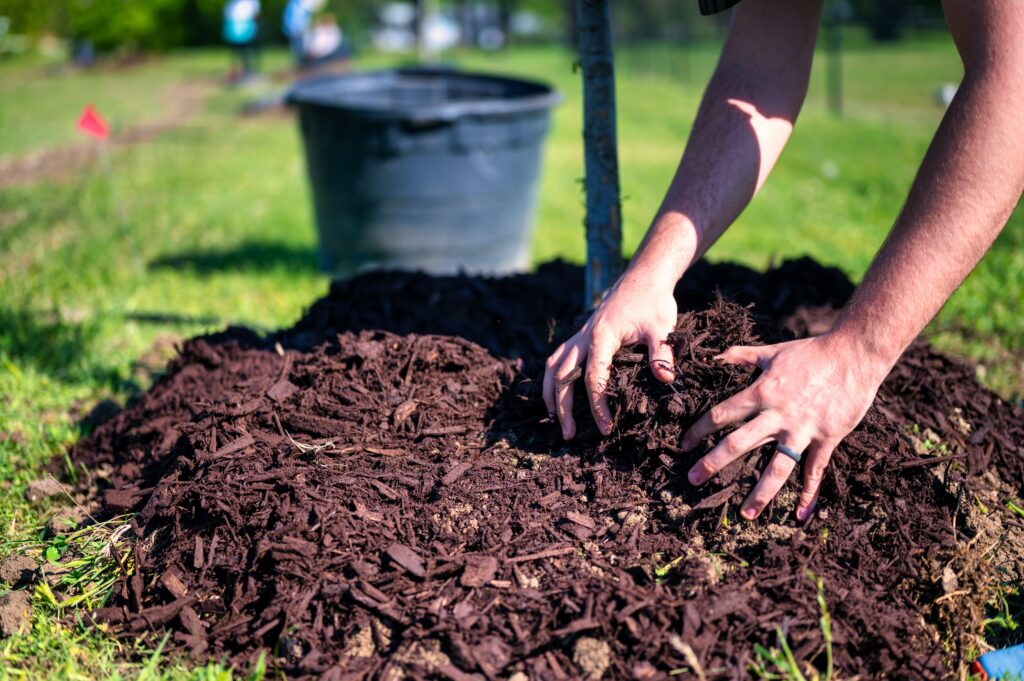
Turn Your Compost
You’ll probably want to do this with the step above of adding browns but turn your compost and mix it up. Turning compost accomplishes a bunch of things that we need for a healthy compost pile.
- Aerates – it adds air and oxygen throughout your compost pile to ensure that you have aerobic composting going on. If your compost pile stinks, you probably have anaerobic composting. Basically, it’s rotting. This attracts flies and other critters and just isn’t pleasant.
- Mixes Browns and Greens – You want to mix up your compost material. Turning helps to ensure that everything is mixed up for better composting.
- Moisturizes – Turning your compost spreads out the moisture in your compost to avoid pockets of wet or dry compost. The compost especially will attract flies.
Turning your compost regularly will help to ensure a healthy, effective compost pile.
Avoid Composting Meat, Dairy, or Fat
Animal products in a backyard compost system will tend to rot and take a while to break down. The smell attracts flies and other things that are much bigger and nastier (think rats, mice, raccoons) that wreak havoc on your compost.
You’re better off avoiding these items for a home composting system. It’s easier just not to compost things like meats, bones, dairy products, or fat.
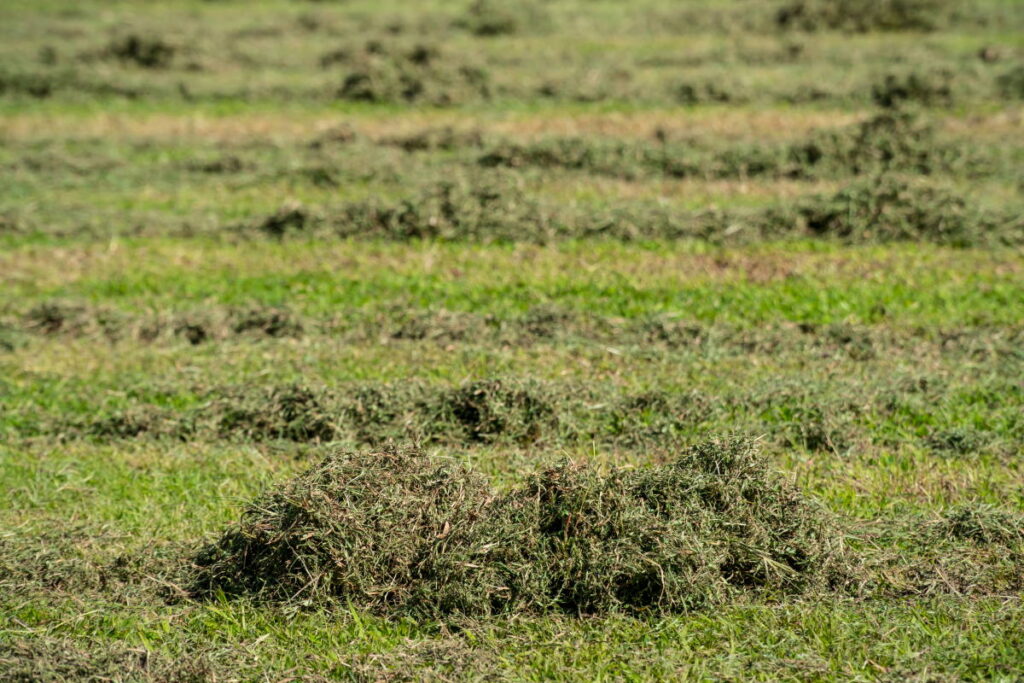
Be Careful With Grass Clippings
Grass clippings are a great addition to your compost. The problem is that if you add too many of them, they bunch up, making thick layers. There is an immense amount of nitrogen in these layers. You guessed it, the dense nitrogen of thick layers of grass clippings attracts flies, so you get maggots in compost.
So, use grass clipping in moderation and make sure that you spread them out throughout your compost. How? Turn your compost (seeing a pattern?) You can also let them dry out, turning brown before adding them. Then they are a brown material and less enticing to the flies.
Adjust the pH of Your Compost
The maggots like a more basic compost, meaning a high pH, not simple. There are a few methods that you can use to lower the pH, which makes it more acidic.
- Add ¼ teaspoon of vinegar for every 5 pounds of material in your compost
- Add a cup of agricultural lime for 25 cubic feet (a fairly normal size home compost pile)
- Add citrus fruit to your compost
- Add pine needles to your compost. These do take a while to compost
Either of these will work, but be careful. If you lower the pH too much, you could do more harm than good. Your garden, and the microbes in the compost, want a particular pH, and if you make it too acidic, you’ll harm them. So, no maggots, no garden, and no microbes to compost.
You can test the soil to get the real pH and adjust from there, but you might be better off trying the other methods first and resorting to this if those aren’t working.
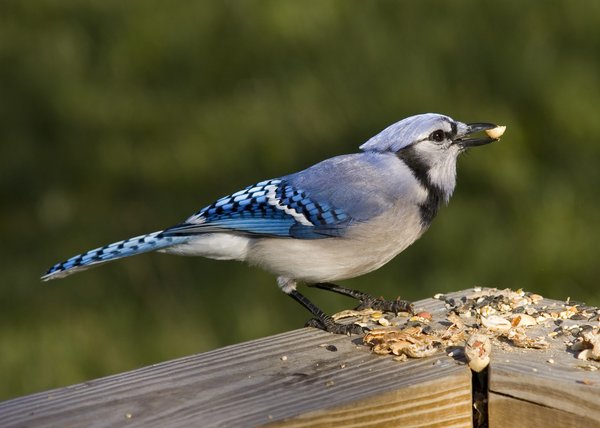
Use Your Bird Friends
One strategy you can try is to take the compost out of the bin and set it on the ground for a day. Birds love maggots, and they are a nice treat. The birds may also eat some larger pieces of food, but this will likely get rid of the maggots.
Keep Flies Out
Your next step to consider is preventing the flies from getting in there in the first place. This will depend a bit on your set-up, but there are several ways that you can consider.
| Type | Actions to Keep Flies Out |
| Tumbler, Bin, Worm Bin | Add screen or mesh to air holes. Ensure any lids are tight fitting, without holes big enough for a fly Buy a sealed bin |
| Compost Pile | Consider changing to a bin or covering your compost pile. |
| Any | Hang fly traps |
Other Bugs in Compost That You Might See
Maggots aren’t the only bugs you may see in your compost. Here are a few other common bugs in compost. Much like maggots in compost, some are a problem, and some aren’t. We’ll go over how to recognize them and how to remove them.
The good news is that many of the steps you’re already taking for making will keep these bugs out of your compost too. Many of these aren’t a problem or aren’t critical.

Ants
Ants are not good for your compost pile at all. They can compete with the other organisms and are there to get rid of the food you are trying to compost. You want to get rid of them, but you need to do that without hurting the rest of your compost pile.
Ants tend to favor a dry environment with food available. Of course, you have food available; that’s the whole point, so we need to treat the dry part.
- Add water to your compost. Your goal is for your compost to be moist but not wet. It should have the consistency of a moist sponge.
- Turn your compost to mix the material and the moisture.
- Repeat until your compost is moist throughout.
- If you add too much water (it drips when you pick it up), then add browns and mix them in.

Centipedes
These predators are bad news for your compost, and these are bugs you want to get rid of. They will eat the other insects and worms you are trying to cultivate for healthy composting. You want to get rid of these as soon as you can. Like ants, centipedes are also attracted to dry compost, and the same measures will help you to get rid of them.
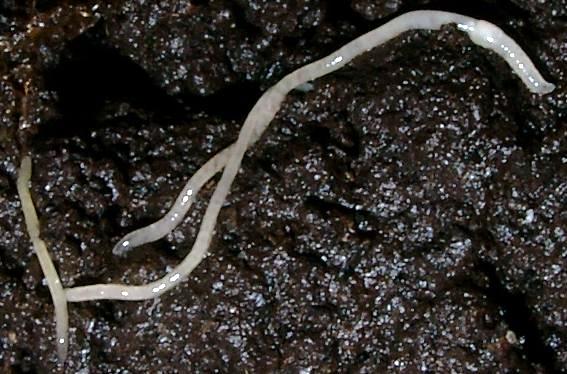
Pot Worms
If there are worms even tinier than maggots squirming around in your compost, they might actually be pot worms. They are little worms that eat waste. They aren’t any risk to your compost. They actually help aerate the compost and can help things out unless…
Pot Worms with Vermicomposting
You might have a problem if you are vermicomposting with red wiggler worms. The conditions that pot worms live in are not friendly to red wigglers, so your compost system might be out of whack, and your red wigglers might be unhealthy.
In these circumstances, pot worms usually indicate that the pH balance is off or the compost is too wet. You might want to try soil testing for the pH. The first step is checking your moisture, which you can do just by looking at it.
If you have water dripping from your compost or it looks muddy, it’s probably too wet. Add some browns and turn it. You can check this every couple of days.
With a red wiggler compost system, once you adjust things, then the pot worms will go away because the conditions are no longer what they like.

Fruit Flies
We have a bin in our kitchen that we collect scraps in before adding them to our compost bin. Periodically, we see little flies gathering around it. These fruit flies don’t really hurt anything, but they are annoying, especially in our kitchen. Interestingly, we have never seen them at the compost pile itself.
If you’ve never seen one, they’re very small flies that are pale brown with red eyes. They’re usually about 1/8” long.
To Remove Fruit Flies From Compost:
- Look for large pieces of fruit in your compost. Remove them from your compost (or cut them up and add them again.) Larger pieces take a while to break down and can attract fruit flies.
- Add a cider and vinegar fruit fly trap.
- Make sure to keep your compost well-aerated (properly turned) so that it gets warm enough to decompose things properly and to keep fruit fly maggots out.

Moth Flies
These flies actually look like moths with brown rounded wings. They’re also called drain flies or psychodid flies). They have square, rounded bodies with large antennae (also making them look like a moth).
They attract organic material (so your whole compost pile) and moist soil. So, adding browns and turning your compost should help keep them away too.

Slugs
These slimy little guys aren’t bad for your compost. They feed on bacteria, but the bigger problem is that they are very bad for plants. They feed on the plants, especially their roots. If you have a large population of worms in your compost, you need to get rid of them before you add your compost to the soil.
Typically, slugs indicate that your compost is too wet. Add some browns, turn them in and continue over a few weeks until your compost is the consistency of a moist sponge. It should be damp but not wet.
If that doesn’t work, you can try a “beer trap”. Seriously. It’s good for more than football games. Here’s what you do:
- Open a can of beer
- Take a sip (optional)
- Pour some into a bowl or tin like a pie tin or small dish, deep enough for them to fall into.
- Leave the plate on your compost (don’t spill it when you turn your compost).
- Drink the remaining beer (optional)
The slugs, well known for bad drinking habits, will go to the plate to take a drink; the idea is that they fall in and drown. Here are some more detailed instructions.
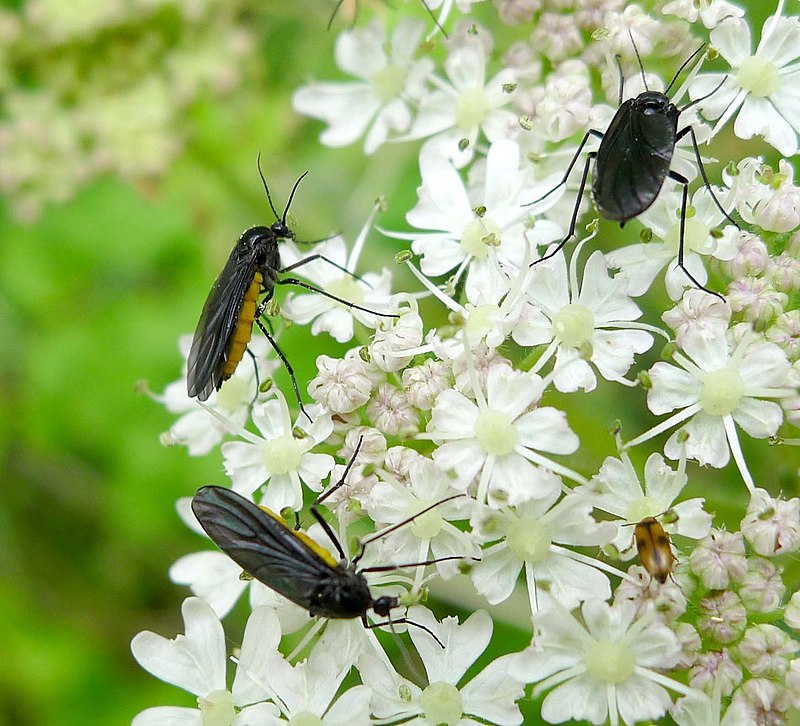
Dark-Winged Fungus Gnats
These gnats are unique from other insects because they can also harm your plants. Unfortunately, they commonly take up residence in compost piles. Typically, you won’t see the maggots in compost because they are too small, but you’ll see the gnats flying around, which means there are probably maggots in the compost pile.
They are dark gray or black with long legs. Their legs let them hop, but they can also fly.
Their maggot children then end up in your soil and damage the root hairs of your plants.
The surest way to get rid of these critters is to use nematodes or mites. Before spending money, you might want to try eliminating the moisture they are attracted to by adding more browns and turning your compost.

Spiders
Honestly, as long as they’re not poisonous (thankfully rare), spiders in compost are harmless. Creepy but harmless. If they scare you too much, squirt them really quick with some water, and they’ll likely leave on their own.

Slater Bugs
You’ve probably seen these before and never known what they’re called. Slater bugs go by many names: roly-polies, pill bugs, and woodlice. You may have seen them when you’ve rolled an old log. They’re not actually insects. They’re crustaceans like shrimp, crabs or crawfish. That doesn’t really matter to us, though. We’re including them because they’re creepy crawlies, whether insects or not.
If you find slater bugs in your compost, celebrate. They’re helping out. They help break down organic material and help you do what you’re trying to do. Leave them alone, and they help your compost decompose (this is why you find them under old logs, they’re at work there too.
Handling Maggots in Compost and Other Bugs in Compost
Composting is a natural process, meaning many of Mother Nature’s creatures have learned to benefit from it and even help it. That doesn’t mean they aren’t gross or that we even want them around, but it often means that they are trying to tell you something. Or that they are trying to help out.
We’ve covered what maggots are, and what causes them. We now know that maggots in compost aren’t necessarily a big deal and can often help things. The problem is that they will often eat many of the nutrients that your plants need, so you don’t necessarily want them hanging out all the time.
They may also indicate that something isn’t quite right in your compost pile. There are ways to change your compost to help prevent them; you can also keep flies out. No flies means no baby flies.
Then we covered a few more bugs in compost and how to deal with them. Of course, these aren’t everything you may see. They are some of the more common ones and more common ways to deal with them.
Hopefully, this has helped, and you can feel better about what you see in your compost.
